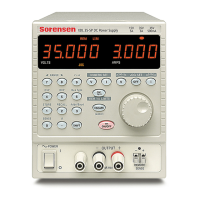21
Use can also be made of the ADDRESS? command to easily identify which instrument is being
controlled by a particular COM port. Although the addressing capability is ignored in USB
operation the address can still be set and used as an identifier; set each USB-connected
instrument to a different address and send the ADDRESS? command from each virtual COM port
to confirm which instrument is connected to that port.
LAN Interface
The LAN interface is designed to comply with the LXI standard version 1.2 and contains the
interfaces and protocols described below. Since it is possible to misconfigure the LAN interface,
making it impossible to communicate with the instrument over LAN, a LAN Configuration Initialize
(LCI) mechanism is provided via a recessed switch on the rear panel to reset the unit to the
factory default. The default setting is for the instrument to attempt to obtain settings via DHCP if
available or, if DHCP times out (30 seconds), via Auto-IP. In the very unlikely event that an Auto-
IP address cannot be found a static IP address of 192.168.0.100 is assigned. Resetting the LAN
removes any password protection.
For more information on LXI standards refer to www.lxistandard.org/home .
LAN Connection
To use the LAN interface, the IP address of the unit must be known. There is a LXI Discovery
Tool on the supplied CD-ROM which can be used to display the IP addresses (and other
associated information) of all connected devices that comply with the VXI-11 discovery protocol.
This tool is a Windows PC application that should be installed and run on the controlling PC with
the unit either connected directly to the PC network connector or via a router. Connecting via a
router is recommended as this is significantly quicker to assign an IP address; connecting directly
to the PC will begin to assign an IP address only after a 30 second DHCP timeout. Double
clicking on any entry in the list of devices discovered will open the PC's web browser and display
the Home page of that device.
There are also tools for LAN discovery included as part of the National Instruments Measurement
and Automation Explorer package and the Agilent Vee application.
The unit will, when first powered up, attempt to obtain settings via DHCP if available or, if DHCP
times out (30 seconds), via Auto-IP. In the very unlikely event that an Auto-IP address cannot be
found a static IP address of 192.168.0.100 is assigned. During this time the LAN lamp above the
Output 2 meters will be lit and it will stay lit if a LAN connection is successfully made. However, if
a connection is still not made by the end of the above process, or if the LAN connector is
physically removed at any time, the LAN lamp will go off; see LAN Error section for details.
Web Server; Configuration Password Protection
The unit contains a basic web server. This provides information on the instrument and allows it to
be configured. The Configure page can be password protected to deter unauthorized changes to
the remote operation configuration; the default configuration is ‘no password’.
The Configure page itself explains how to set the password. The password can be up to 15
characters long; note that the User Name should be left blank. The password will, however, be
reset to the default (no password) if the rear panel LAN RESET switch is used to reset all the LAN
parameters to their factory default.
The web pages also have an ‘Identify’ function which allows the user to send an identifying
command to the instrument which causes its displays to flash until the command is cancelled.
ICMP Ping Server
The unit contains an ICMP server allowing the instrument to be ‘pinged’ via either its host name
or IP address.

